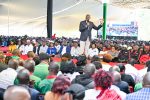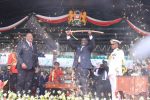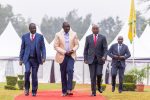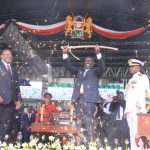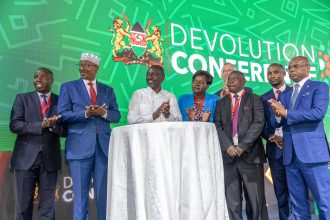With slightly over two years to Kenya’s election, a new political alliance is shaping up bringing together President William Ruto and ODM leader Raila Odinga.
While the two have come together through a unity pact outlining a 10-point agenda, it is becoming evident that their cooperation is set to move beyond Ruto’s first term which ends with the 2027 elections.
In the tightly contested 2022 presidential election, Ruto secured a narrow victory with 50.49 per cent of the vote, amassing 7,176,141 votes against Raila’s 48.85 per cent, or 6,942,930 votes, out of 14,326,641 total votes cast.
With a voter turnout of 64.77 per cent from 22,120,458 registered voters, the election highlighted Kenya’s polarised electorate.
As Ruto looks toward a second term in 2027, cracks in his 2022 support base, particularly in the Mount Kenya region, are becoming evident.
To shore up his chances, Ruto is aligning with his former rival, Raila Odinga, hoping to tap into Raila’s loyal voter base in Luo Nyanza, Western Kenya, and the Coast.
However, with Kenya’s youthful population, 75 per cent under 35, and growing voter apathy fuelled by the absence of fresh political faces, the youth vote could either tilt the scales or deepen the electoral malaise.
Today, we analyse how Raila’s support, combined with the dynamics of young voters, could shape Ruto’s re-election bid, using 2022 election data as a foundation.
The 2022 Election: A Fragile Victory Shaped by Youth
The 2022 election saw Ruto’s United Democratic Alliance (UDA) and Kenya Kwanza coalition narrowly defeat Odinga’s Azimio la Umoja coalition, with Ruto’s success anchored in Mount Kenya (2,938,309 votes) and North Rift (1,602,807 votes), which together contributed 63% of his total votes.
Raila dominated in Nairobi (767,395 votes), Kisumu (419,997 votes), and Homa Bay (399,784 votes), drawing significant support from Luo Nyanza and parts of the Coast.
Voter turnout, at 64.77 per cent, was notably lower than 2017’s 78 per cent, reflecting disillusionment amid economic woes like inflation and unemployment.
Young voters, constituting over 8.8 million of the registered electorate (40 per cent of total voters), were pivotal in 2022.
Ruto’s “hustler” narrative, promising economic empowerment for the marginalised, resonated strongly with this demographic, particularly in urban centers.
However, low turnout in youth-heavy regions like Mombasa (44 per cent) and Kilifi (49 per cent), compared to high turnout in Ruto-leaning counties like Baringo (80 per cent) and West Pokot (79 per cent), suggests that apathy among young voters disproportionately affected Raila’s base.
As 2025 unfolds, Ruto’s 2022 coalition faces challenges. Economic policies, such as fuel subsidy cuts, have sparked protests, particularly in Mount Kenya, where there is growing discontent among Kikuyu voters over unfulfilled promises.
This erosion threatens Ruto’s 2.9 million votes from the region. To counter this, Ruto has turned to Raila, whose influence in Luo Nyanza, Nairobi, and the Coast could deliver critical votes.
Raila’s 2022 performance in Kisumu and Homa Bay alone yielded over 800,000 votes, and his sway in Nairobi (1.35 million votes cast) remains significant.
However, the youth vote introduces a wildcard. Kenya’s young population, frustrated by economic stagnation and a lack of new political faces, is increasingly apathetic.
The 2022 election already showed a 13 per cent drop in turnout from 2017, with urban youth in Nairobi and Mombasa least likely to vote.
The prospect of a Ruto-Raila alliance—two political veterans aged 58 and 80 by 2027—risks further alienating young voters craving fresh leadership.
A 2024 survey found that 60% of voters aged 18–35 felt unrepresented by current leaders, and only 45 per cent expressed intent to vote in 2027 if the contest features familiar candidates.
Potential Ruto Opponents and Their Prospects
Several opposition figures are emerging as potential challengers, each with distinct strengths and challenges. A united opposition candidate could significantly alter the race, especially if they capitalise on youth frustration and Mount Kenya defections.
Former Vice President and Raila’s running mate in 2013 and 2017, Kalonzo Musyoka declared himself the opposition leader after Raila’s AUC bid and commands support among the Kamba community in Ukambani (1.2 million votes in 2022).
Musyoka’s calm demeanour and anti-Ruto stance resonate with youth seeking a unifying figure. His alliance with former Deputy President Rigathi Gachagua and the Gikuyu, Embu, Meru Association (GEMA) could secure Mount Kenya votes.
In 2022, Kitui, Machakos, and Makueni delivered 600,000+ votes to Azimio, and Musyoka could retain these while gaining in Nairobi. However, his limited national appeal and past electoral losses weaken his candidacy.
Alone, Kalonzo may struggle to surpass 6 million votes, but with Gachagua and youth support, he could force a runoff.
Former Interior Minister under Uhuru Kenyatta, Fred Matiang’i announced his 2027 candidacy, leveraging his reputation for competence and reform and hails from Kisii, with influence in Nyanza and among Gen Z.
Matiang’i’s anti-establishment image appeals to youth frustrated with Ruto’s policies and Raila’s alliance. Kisii and Nyamira counties delivered 300,000 votes to Azimio in 2022, and Matiang’i could expand this with urban youth support in Nairobi and Mombasa.
However, his lack of a political party and limited ethnic base pose challenges. Matiang’i could draw 2–3 million votes from Nyanza, Nairobi, and youth, but without a broad coalition, he risks splitting the opposition vote.
Impeached Deputy President Rigathi Gachagua is rallying Mount Kenya against Ruto, positioning himself as a Gen Z ally and his influence in Mount Kenya, which delivered 2.9 million votes in 2022 for Ruto, makes him a formidable contender.
His anti-Ruto rhetoric and youth alignment could boost turnout in Central Kenya and urban areas. However, his impeachment and legal battles may tarnish his credibility, and there are suggestions he’s stronger as a kingmaker than a candidate.
Gachagua could secure 2–3 million votes from Mount Kenya but struggles to appeal beyond Kikuyu voters, limiting his solo prospects.
Former Chief Justice David Maraga entered the 2027 race promising ethical leadership the Supreme Court’s 2017 nullification of Uhuru Kenyatta’s election win earned him credibility among opposition supporters.
Maraga’s perceived clean image appeals to youth and Kisii voters (300,000 votes in 2022). However, suspicions of state backing to split the Kisii vote and his lack of political infrastructure weaken his candidacy.
Maraga may draw 1–2 million votes but is unlikely to win without a major coalition.
Former Justice Minister and Raila’s 2022 running mate, Martha Karua, leads the rebranded People’s Liberation Party after exiting Azimio and appeals to Central Kenya and youth.
Karua’s anti-government stance and gender appeal could mobilise women and youth, but her limited ethnic base (Meru and Kikuyu) and Narc Kenya’s weak structure cap her reach.
In 2022, Meru delivered 200,000 votes to Azimio and nationally Karua could secure 1–2 million votes but risks fragmenting the opposition without unity.
Simulating 2027: Raila’s Support and the Youth Vote
To evaluate Ruto’s re-election prospects, let us simulate two scenarios for 2027, assuming a 65 per cent turnout from 22.1 million registered voters (14.3 million votes cast) and a youth voter share of 40 per cent(5.7 million votes). A candidate needs over 7.15 million votes and 25 per cent in 24 counties to win in the first round.
Scenario 1: Ruto Retains Core Base, Gains Raila’s Support, but Opposition Fragmented
Suppose Ruto retains 80 per cent of his 2022 Mount Kenya votes (2.35 million) despite discontent, holds his North Rift base (1.6 million), and secures 50 per. cent of Raila’s Luo Nyanza votes (600,000 from Kisumu and Homa Bay) through an alliance.
He also gains 400,000 votes in the Coast (up from 324,353) and maintains votes in Nairobi (561,775) and Nakuru (455,864).
However, youth turnout drops to 55 per cent (3.1 million of 5.7 million potential youth votes), with only 40 per cent of young voters (1.24 million) backing Ruto due to disillusionment with the Ruto-Raila pact.
This yields approximately 7.3 million votes—51 per cent of the total, barely securing a first-round win. A fragmented opposition, with Kalonzo (3 million), Matiang’i (2 million), and others splitting votes, fails to force a runoff.
Raila’s support proves crucial, but low youth turnout limits the margin, making the outcome vulnerable to opposition mobilisation.
Scenario 2: Ruto gains marginally from Raila, a United Opposition
Now, assume Ruto loses 50 per cent of Mount Kenya votes (1.47 million) due to widespread alienation, retains his North Rift base (1.6 million), and gains only 25 per cent of Raila’s Luo Nyanza votes (300,000) due to skepticism among Raila’s supporters.
His Coast votes remain at 324,353, and Nairobi and Nakuru hold steady. Critically, youth turnout plummets to 50 per cent (2.85 million votes), with only 30 per cent (855,000) supporting Ruto, as young voters reject the “recycled” Ruto-Raila ticket.
This results in roughly 5.8 million votes 40 per cent of the total giving the united opposition an edge.
A united opposition candidate, say Kalonzo backed by Gachagua, Matiang’i, and Karua, consolidates Mount Kenya (1.5 million), Ukambani (600,000), Kisii (300,000), and 60% of youth votes (1.7 million), plus Nairobi and Coast, reaching 7.5 million votes (52 per cent).
The opposition’s wave election, fuelled by youth mobilisation and a rejection of Ruto-Raila’s “dynastic” pact, secures victory
The Youth Factor: Opportunity and Risk
Young voters could tilt the scales, but their apathy poses a significant hurdle. In 2022, Ruto’s “hustler” narrative mobilised urban and rural youth, but economic challenges like inflation and youth unemployment have eroded trust.
The Ruto-Raila alliance, while strategically sound for consolidating regional votes, risks alienating young voters who see it as a betrayal of the “hustler” promise to disrupt dynastic politics.
To win over youth, Ruto would need to address economic grievances, job creation, affordable education, and counter perceptions of elitism in his alliance with Raila.
Raila’s influence could help, particularly in Nairobi, where 60 per cent of voters are under 35, but his age and long political history may limit his appeal. If youth turnout drops below 50 per cent, the total vote pool shrinks, amplifying the importance of regional strongholds but reducing the impact of youth as a swing bloc.
President Ruto’s bid for a second term in 2027 hinges on balancing his eroding 2022 support base with Raila Odinga’s loyal voters while navigating the critical youth demographic.
The 2022 election data shows Ruto’s reliance on Mount Kenya and North Rift, but discontent in these areas threatens his prospects. Raila’s support could deliver 600,000–800,000 votes from Luo Nyanza and the Coast, potentially securing a first-round victory if youth turnout remains moderate.
However, growing apathy among young voters, fuelled by the lack of new faces in a Ruto-Raila alliance, could depress turnout and empower an opposition candidate in a runoff.
With Kenya’s youth holding the potential to sway 5.7 million votes, their engagement, or disengagement, will be as crucial as any regional coalition in determining whether Ruto’s gamble on Raila pays off.
A united opposition candidate, likely Kalonzo or Matiang’i, could reshape the race by consolidating Mount Kenya, Ukambani, and Nyanza votes while appealing to youth. The 2002 election, where a united NARC coalition ousted KANU, offers a precedent.
Gachagua’s Mount Kenya base, paired with Musyoka’s Ukambani and Matiang’i’s youth appeal, could deliver 5–6 million votes, forcing a runoff or outright win if youth turnout exceeds 60 per cent.
However, opposition unity faces hurdles: Gachagua’s legal battles, Musyoka’s limited national appeal, and ODM’s potential to field a candidate could fragment votes.
Ruto’s control of state resources and IEBC vulnerabilities further tilt the playing field.
